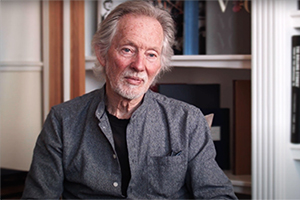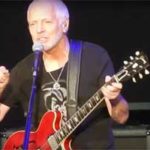Bassist/visual artist’s first-hand recounting of life in the Beatles’ inner circle
By Gary Graff
May 3, 2021
Klaus Voormann is often thought of, first, as a visual artist, thanks to album covers for bands such as the Beatles, Bee Gees, Harry Nilsson and more. The German-born Voormann’s legacy as a bassist, however, is even more impressive. He played on multiple albums for Beatles John Lennon, George Harrison, and Ringo Starr as well as outings by Nilsson, Donovan, Peter Frampton, Badfinger, Dion, B.B. King, Jerry Lee Lewis, Randy Newman and many more. And that’s Voormann’s rolling bass figure that opens Carly Simon’s hit “You’re So Vain.” He’s made his mark with four strings, in other words, and while he no longer plays and is focused on art — look for his cover of the next Scorpions album — Voormann, now 82, has fond memories of his work in the studio and on stage, and he’s particularly digging the recently released John Lennon/Plastic Ono Band: The Ultimate Edition box set…
FBPO: What led you to play bass?
Voormann: I learned classical guitar when I was in Tenerife, where Paul (McCartney), George and Ringo visited me, because we’d become friends when (the Beatles) started playing in Hamburg. I didn’t even think of playing in a band or being professional on stage or anything. I just wanted to play guitar for myself. Then suddenly a friend of mine from Hamburg called me to play bass, so I was in a band and I was playing bass. If you play classical guitar it’s really easy to play the bass. I just always liked it. I could’ve played the piano or the guitar, but I always played the bass.
FBPO: What did you like about it?
Voormann: It’s interesting, because I never really thought about it ’til I listened to tracks when the bass is not there. And if the bass is not there, it suddenly gets very empty. I know lots of records where I hate the bass — it’s too busy or the notes are too bassy. I like bass when it really fits together with the rhythm section. That to me is really important. And if it’s necessary and there’s space for it, I like it when it’s melodic, too.
FBPO: Speaking of rhythm sections, you’ve played with a lot of drummers — and some of the greats. Who have been your favorites?
Voormann: Well, in the first place Ringo, definitely, and then Jim Keltner. There was a lot of playing with Jim Gordon, too. But I’ll tell you what; I didn’t play with all that many different drummers, because most of the stuff I did was with Keltner or Ringo. There were a few other ones, but not many. I’m not, like a typical session guy. So, yeah, Keltner and Ringo.
FBPO: What’s your preferred bass over the years?
Voormann: The very first bass I played was this Hofner bass I bought from Stuart Sutcliffe, the (original) bass player of the Beatles. Then I got a Precision and I never played another bass — never changed the strings (laughs), played that same instrument all the way through my career. Of course I always had a second bass around if anything happened to the (Precision), but even when I tried to play different bass guitars, everybody would always be like, “Come on, go back to your Precision,” so I always played that Precision bass. I didn’t experiment with other instruments. My son has it now.
FBPO: You’re also well known for your visual artwork. Did that and bass playing go hand in hand? Did one have any sort of impact or influence on the other?
Voormann: No, they didn’t, really. I don’t think that you can really illustrate or draw music. You can’t do that. Music is one thing for me and graphics is another, and it was a very difficult thing for me to be doing music and then suddenly somebody asks me to do graphics — which happened when did (the Beatles’) Revolver cover. I hadn’t’ touched a brush or a pen or ink or anything for months, and suddenly I was asked to draw something, and it was very difficult. So those are two very, very different things. It was difficult to do both at the same time, so I usually kept them separate.
FBPO: You played sessions with John Lennon, George Harrison and Ringo Starr, and even live with John. Can you compare and contrast the way they worked?
Voormann: Well, George had a way about him. I knew him really well and I lived in his place, too, so we really got into those songs and we played them together. He always prepares the sessions nicely; He gives time and we sit down and when he develops his solos that takes another whole bunch of time. It’s very peaceful. With George it was more the melodic feeling and the space of the compositions, and he put much more time into the records. With John it was more inspired by the way he was playing or what he was saying, more directly. And Yoko was always a great catalyst for him. Ringo, always, is need of help. He’s good when he’s with other people, and he’s incredible, so much fun. Ringo is more like a Cocker Spaniel to me when he’s doing a song.
FBPO: The new John Lennon/Plastic Ono Band box set is out now. That was John’s first “proper” solo album, and a lot of fans’ favorite of his. What do you remember about those sessions?
Voormann: This, to me, is a milestone. This record is so special — not only for John but for anybody who listens to it. I think it was uncertain what was going to come, what was going to happen in the studio. But as soon as we started playing and as soon as he realized we were actually getting into the songs he was doing…then (Lennon) started feeling very secure. It was the first time I really saw John being really happy. He was happy with Yoko and he was still all worked up because of the primal scream (therapy) he went through. And out of those feelings came those songs he was doing. It’s so direct, and it’s so simple. To me it’s magic. There’s so much emotion in it. There’s happiness. There’s sadness. There’s pain. It’s all in there. This LP will never die.
FBPO: Before Plastic Ono Band you were part of the Plastic Ono Band, with Eric Clapton, that played at the 1969 Toronto Rock and Roll Revival festival — famously without rehearsing. How did that differ from the studio experience?
Voormann: The Toronto thing, the gig, was a joke. How dare John Lennon get out there with a band that never played together, never rehearsed, doesn’t know the songs! I mean, there’s poor Alan White, he didn’t know what instrument he was playing. So it was scary in a way. It was just a trip John was on, to go out there and be John Lennon and play a few rock ‘n’ roll songs. It was fun to play, yes, but we played wrong notes and we played the wrong thing for the songs. It was fun, but it was crazy. And you can’t compare it to what we did later, making the (Plastic Ono Band) album.
FBPO: One of your best-known bass lines was the opening of Carly Simon’s “You’re So Vain.” Did you know at the time you were playing on a No. 1 hit?
Voormann: No, no, I didn’t know. I only know that the song was interesting, about this guy traveling around the world in a yacht and having a big house and… a flashy guy. I thought it was a good set-up, and that’s why I started playing that bass intro. That’s all there is to that.
FBPO: You played on sessions for both B.B. King and Jerry Lee Lewis during the early ‘70s. Discuss, please.
Voormann: Well, B.B. was lovely. He was such a great person, and he was very pleasant in the studio. It was never a hassle. He was very much, let’s say, a servant to the producer. He did not direct the sessions. He just played, and every time he played, he played great. He does beautiful solos and great singing. So he was really fun. Jerry Lee was a little different. He was, I would say, half-drunk, not exactly full drunk. It was a bit of a mess, those sessions — there were so many musicians, not very organized. The nice thing was he actually came and said to me, “Come on, play really simple,” which I did because for him, of course, it was the right thing. But it was such a mess. I just tried to keep my end down. There wasn’t much more to be done.
See Jon’s blog, with key takeaways from this interview here.




Always loved Voorman’s bass playing and artwork. I exchanged a few emails with him about ten years ago – very pleasant and appreciative fellow. He also played bass on ‘The Mighty Quinn’ (Manfred Mann), ‘It Don’t Come Easy’ (Ringo), most of Lennon’s ‘Imagine’ album (including title song), most of Ringo’s ‘Ringo’ album (including Ringo’s only two #1 singles), ‘Basketball Jones’ (Cheech & Chong), ‘Mockingbird’ (Carly Simon & James Taylor), ‘Short People’ (Randy Newman), ‘Perfect Day’ (Lou Reed), and much much more!
When you wrote “Klaus Voormann is often thought of, first, as a visual artist” I thought to myself “I didn’t even know he was a visual artist, he’s a bassist”.
No mention of amps. Any preferences, or just what was available?
the total opposite of a self absorbed “wanker”. So refreshing, but I suppose it the all types